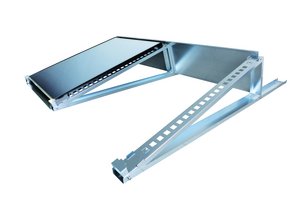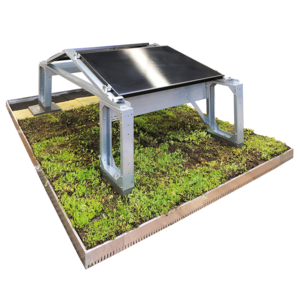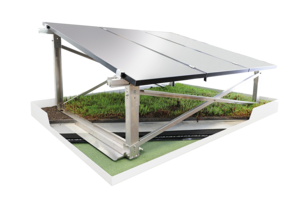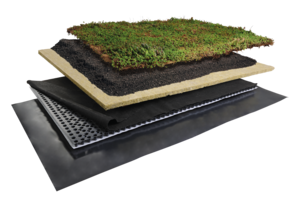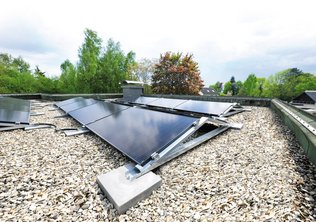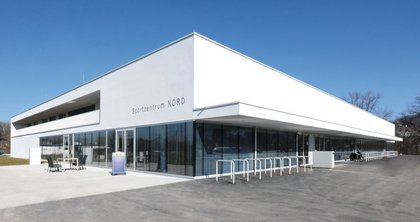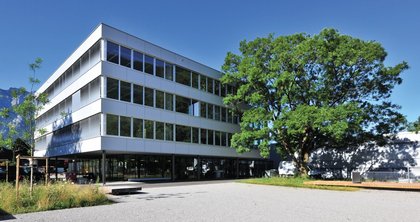![[Translate to Englisch:] PV-Unterkonstruktionen der Firma Richard Brink in Ost-West-Ausrichtung auf Flachdach mit Kiesschüttung. Zeigt die gesamte Konstruktion bestehend aus Solarpanel, Befestigung an der Unterkonstruktion und Ballastierung.](/fileadmin/user_upload/MiraluxFlex_OW_Header.jpg)
Trust in more than 45 years of experience
Made-to-measure production from Germany
Miralux Flex solar substructure (east-west-facing)
For continuous energy generation
- Non-penetrative and low-ballast mounting system for flat roof surfaces
- Aerodynamically optimised
- Minimal storage space required, easy handling
- Integrated cable channels
- Additional fixing elements that can be adjusted to hold commercially available panels
- Expandable modular system
Any questions? We are happy to help personally!
The Miralux solar substructures provide the perfect basis for your flat-roof photovoltaic system. You benefit not only from their quick construction time, but also their easy handling. The Miralux products require minimal storage space and are quick to assemble without penetrating the roof cladding. They feature integrated cable channels and are extremely hard-wearing, made from hot-dip galvanised steel with a Magnelis coating or, on request, from aluminium. All models have been aerodynamically optimised in wind-tunnel tests, reducing the amount of ballast needed.
The east-west-facing photovoltaic substructure pictured here is designed for continuous energy generation throughout the entire day. Our latest Miralux Flex model offers even greater flexibility for structuring your photovoltaic systems as standard. Special clamps are used as fixing elements that are fixed to either side of the mounting system. These enable easy mounting of solar panels in a range of commercially available sizes. Ballast supports and two types of screwable ballast blocks (16kg or 34kg) made from polymer concrete are available as accessories, also for installation in gravel or on green roofs.
Solarunterkonstruktion in Ost-West-Ausrichtung
| Angle: | Material: | Material thickness: |
| 10° 15° | Magnelis®-coated hot-dip galvanised steel, aluminium (on request) | 1,5 mm |
| Shadow angle: | Lateral distances between modules: | Info: |
| (<15°) | module-specific | Cable channel integrated (into the base support) Preservation of structures (optional): EPDM or needle felting (pre-installed on request) Processing time: incl. wiring approx. 10 mins per kWp (two-person installation) |
Video: Einbauanleitung
Frequently asked questions about Miralux Flex East-West
1. An east-west-facing set-up enables continuous energy generation throughout the day. This is because the solar panels can catch both the morning sun on the east side and also the evening sun on the west side. This spreads the yield of the photovoltaic system across the whole day and reduces peak output at midday, resulting in more even energy production.
2. The east-west-facing version is also beneficial in terms of aerodynamic performance. All Miralux Flex solar substructures have been aerodynamically optimised in wind tunnel tests, making them comparatively low ballast, which contributes to improved stability, even at high wind speeds.
Key features of the Miralux Flex solar substructures are their exceptional ease of assembly, non-penetrative installation as well as the ability for a range of commercially available panel sizes to be installed and more. Additionally, the systems are made from hot-dip galvanised steel with a Magnelis® coating or from aluminium (on request), which makes them permanently resistant to external influences.
The Miralux Flex systems are designed to save space during transport and on site. Thanks to their prefabricated folding elements, the systems can be assembled extremely quickly and without the need for tools.
Yes, the systems can be easily extended – also retroactively – thanks to the modular construction of the solar substructures.
The systems guarantee excellent structural stability thanks to their favourable flow behaviour, even when exposed to high wind speeds. The ballast blocks, which can also be used on green and gravel roofs, contribute additional stability.
Yes, the systems are equipped with integrated cable channels that ensure that all cabling is safe and tidy.
The products are very lightweight, reducing distributed load by up to 75% compared with traditional systems, without overloading the roof structure.
Yes, the systems have proven lightning current carrying capability, which is essential to the safety of the system.
Indeed, you will not be subject to any warranty obligations for roof surfaces due to the installation of solar substructures if such installation does not require the roof cladding to be penetrated.
Our solar substructures in practice
A stable photovoltaic system in next to no time
Richard Brink solar substructures for residential flat roofs
Gütersloh, 23/11/2023. A project in Gütersloh, Germany, showcases the exceptional functionality of Richard Brink GmbH & Co. KG’s Miralux Flex substructure systems for solar panels, which can be implemented on the roof surface without intensive…
Read moreParapet coverings unite façade elements on the new sports centre in Salzburg
The Sportzentrum Nord sports centre in Salzburg’s Liefering district offers its users numerous training opportunities, including football, basketball and climbing. The new three-court sports hall was completed on the sports area at…
Read moreSolar modules optimally aligned thanks to substructures
A rooftop system for a building’s own energy generation – for many companies, infrastructural facilities and private homes, solar modules represent an extremely economical solution that is also environmentally friendly. To get the most out of the…
Read more
![[Translate to Englisch:] PV-Unterkonstruktion "Miralux Flex" der Firma Richard Brink in Ost-West-Ausrichtung mit allen Einzelteilen inklusive Ballastierung und Modulklemmen.](/fileadmin/_processed_/8/9/csm_2_Mi_FS_02_9fd74a9e97.png)
![[Translate to Englisch:] PV-Unterkonstruktion von Richard Brink in Ost-West-Ausrichtung. Zeigt die Anbringung des Solarpanels oberhalb der Unterkonstruktion.](/fileadmin/_processed_/e/c/csm_MiraluxFlex_OW_Slider_4682fdfb69.png)
![[Translate to Englisch:] Zwei Ballastierungssteine aus Polymerbeton der Firma Richard Brink zur Ballastierung von Photovoltaik-Unterkonstruktionen. Große Variante mit 34 kg, kleine Variante mit flacher Bodenplatte (16 kg) zum Einbringen in Kiesbetten oder Gründächer](/fileadmin/_processed_/7/d/csm_2_Mi_FS_03_9ca2a7f2ca.png)
![[Translate to Englisch:] Ballastierungsunterstützung der Firma Richard Brink. Gekantetes Blech zur Einlage von Betonplatten oder Steinen, um Photovoltaik-Unterkonstruktionen zu beschweren.](/fileadmin/_processed_/9/f/csm_2_Mi_FS_04_6e016a396e.png)
![[Translate to Englisch:] Grafische Darstellung der Verschraubung von Ballastierungssteinen unterhalb der PV-Unterkonstruktion. Flache Bodenplatte des Steins liegt unterhalb von Kies und Bepflanzung.](/fileadmin/_processed_/a/6/csm_2_Mi_FS_06_44d13c3c81.png)
